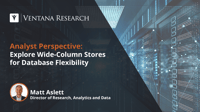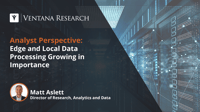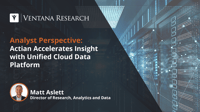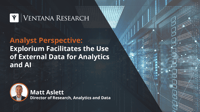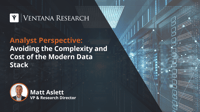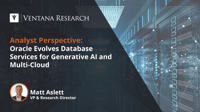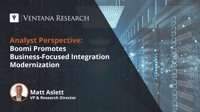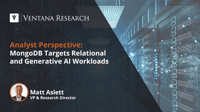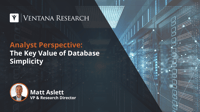I have previously written about the functional evolution and emerging use cases for NoSQL databases, a category of non-relational databases that first emerged 15 or so years ago and are now well established as potential alternatives to relational databases. NoSQL is a term used to describe a variety of databases that fall into four primary functional categories: key-value stores, wide-column stores, document-oriented databases and graph databases. Each is worthy of further exploration, which is...
Read More
Topics:
Data,
data operations
Discussion about potential deployment locations for analytics and data workloads is often based on the assumption that, for enterprise workloads, there is a binary choice between on-premises data centers and public cloud. However, the low-latency performance or sovereignty characteristics of a significant and growing proportion of workloads make them better suited to data and analytics processing where data is generated rather than a centralized on-premises or public cloud environment. ...
Read More
Topics:
Cloud Computing,
Internet of Things,
Data,
Digital Technology,
Analytics & Data,
operational data platforms,
Analytic Data Platforms,
AI and Machine Learning
As articulated in Ventana Research’s Data Platforms Buyer’s Guide and DataOps Buyer’s Guide research, the combination of cloud computing and advanced analytics has lowered the cost of storing and processing large volumes of data, accelerating the emergence of new data platform and data operations products that enable organizations to gain operational efficiency and competitive advantage. The right combination of data platform and data management products is essential to ensure that the right...
Read More
Topics:
Data Management,
Data,
Digital Technology,
data operations,
Analytics & Data,
operational data platforms,
Analytic Data Platforms
The phrase ‘big data’ may have largely gone out of fashion, but the concept of storing and processing all relevant data continues to be important for enterprises seeking to be more data-driven. Doing so requires analytic data platforms capable of storing and processing data in multiple formats and data models. This will be an important focus for the forthcoming Data Platforms Buyer’s Guide 2024.
Read More
Topics:
Analytics,
Business Intelligence,
Data Management,
Data,
Digital Technology,
data operations,
Analytics & Data,
AI and Machine Learning
I recently discussed how fashion has a surprisingly significant role to play in the data market as various architectural approaches to data storage and processing take turns enjoying a phase in the limelight. Pendulum swing is a theory of fashion that describes the periodic movement of trends between two extremes, such as short and long hemlines or skinny and baggy/flared trousers. Pendulum swing theory is similarly a factor in data technology trends, with an example being the oscillation...
Read More
Topics:
Analytics,
Cloud Computing,
Data Management,
Data,
Digital Technology,
data operations,
Analytics & Data,
AI and Machine Learning
I previously described how Oracle had positioned its database portfolio to address any and all data platform requirements. The caveat to that statement at the time was that any organization wanting to take advantage of the company’s flagship Oracle Autonomous Database could only do so using Oracle Cloud Infrastructure (OCI) cloud computing service, their own datacenter or a hybrid cloud environment. The widespread popularity of Oracle Database and the advanced automation capabilities delivered...
Read More
Topics:
Analytics,
Business Intelligence,
Cloud Computing,
Data Management,
Data,
Digital Technology,
Analytics & Data,
operational data platforms,
Analytic Data Platforms,
AI and Machine Learning
I recently articulated some of the reasons why IT teams can fail to deliver on the business requirements for data and analytics projects. This is an age-old and multifaceted problem that is not easily solved. Organizations have a role to play in alleviating the issue by ensuring that their business processes and project planning support a collaborative approach in which business and IT professionals work together. Data and analytics product vendors can also help by delivering products that are...
Read More
Topics:
Cloud Computing,
Data Governance,
Data Management,
Data,
Digital Technology,
Analytics & Data,
AI and Machine Learning
I previously wrote about how document-database providers have added support for ACID transactions and the SQL query language, making their products increasingly suitable for use as replacements for applications that previously depended on relational databases. Adoption of non-relational NoSQL databases is by no means reliant on displacing incumbent relational databases, and initial adoption is often driven by differentiating capabilities, such as developer agility and application flexibility....
Read More
Topics:
Data,
operational data platforms
I have previously written about the functional evolution and emerging use cases for NoSQL databases, a category of non-relational databases that first emerged 15 or so years ago and are now well established as potential alternatives to relational databases. NoSQL is a term used to describe a variety of databases that fall into four primary functional categories: key-value stores, wide-column stores, document-oriented databases and graph databases. Each is worthy of further exploration, which is...
Read More
Topics:
Cloud Computing,
Data,
Digital Technology,
Analytics & Data,
operational data platforms
I previously wrote about the challenge facing distributed SQL database providers to avoid becoming pigeonholed as only being suitable for a niche set of requirements. Factors including performance, reliability, security and scalability provide a focal point for new vendors to differentiate from established providers and get a foot in the door with customer accounts. Expanding and retaining those accounts is not necessarily easy, however, especially as general-purpose data platform providers...
Read More
Topics:
Analytics,
Cloud Computing,
Data,
Digital Technology,
Analytics & Data,
Streaming Data & Events,
Analytic Data Platforms,
AI and Machine Learning
